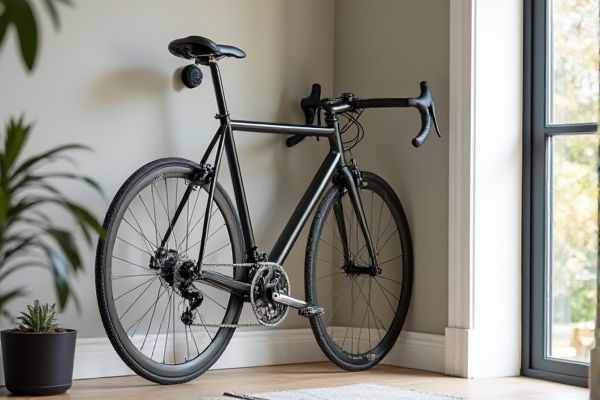
Bike hooks offer a space-saving solution by allowing you to hang your bike vertically on walls or ceilings, suitable for small storage areas. Bike racks provide versatile and stable parking options for multiple bikes, often used outdoors or in garages; explore the rest of the article to determine which option best fits your needs.
Table of Comparison
| Feature | Bike Hooks | Bike Racks |
|---|---|---|
| Installation | Wall or ceiling mounted, requires drilling | Freestanding or ground-mounted, may require anchoring |
| Space Efficiency | Highly space-saving, ideal for small areas | Requires more floor space, suitable for open areas |
| Capacity | Typically holds one bike per hook | Varies from 2 to 10+ bikes per rack |
| Bike Protection | Minimal padding, risk of bike damage if not careful | Often padded or designed to secure bikes safely |
| Cost | Generally lower cost | Higher cost, varies with size and material |
| Best Use | Indoor storage, garages, apartments | Outdoor parking, public spaces, multi-bike storage |
Introduction to Bike Storage Solutions
Bike hooks and bike racks are essential bike storage solutions designed to maximize space and protect bicycles from damage. Bike hooks, typically mounted on walls or ceilings, offer vertical storage ideal for compact areas, while bike racks provide horizontal or freestanding options suitable for multiple bikes. Choosing between bike hooks and bike racks depends on available space, bike type, and user convenience, with both solutions enhancing organization and bike longevity.
What Are Bike Hooks?
Bike hooks are wall-mounted or ceiling-mounted devices designed to securely hold your bike by its frame or wheels, optimizing storage space in garages or small areas. Unlike bike racks, which provide stable ground-level parking for multiple bikes, bike hooks maximize vertical space, making them ideal for compact environments. Your choice between bike hooks and racks depends on available space and ease of access for daily use.
What Are Bike Racks?
Bike racks are sturdy frameworks designed to securely hold multiple bicycles in public or private spaces, typically made from steel or aluminum to withstand outdoor conditions. They offer organized parking, often featuring slots or loops where bike tires or frames can be locked, enhancing security against theft. Commonly installed in urban areas, schools, and workplaces, bike racks support sustainable transportation by encouraging cycling through convenient, accessible bike storage solutions.
Space Efficiency Comparison
Bike hooks maximize vertical storage by utilizing wall or ceiling space, ideal for small areas and apartments with limited floor room. Bike racks often require floor clearance, making them less space-efficient in tight environments but easier for access and organization when storing multiple bikes. Your choice depends on balancing compact storage needs with ease of bike management.
Installation and Setup Differences
Bike hooks require minimal installation, typically involving mounting a single hook or set of hooks directly into a wall or ceiling stud, making them ideal for small spaces and quick setups. Bike racks often demand more complex installation, such as anchoring a freestanding rack or bolting a multi-bike system into the ground or wall, providing stable, organized storage for multiple bicycles. While hooks offer simplicity and space efficiency, racks deliver enhanced capacity and security with a more involved setup process.
Weight Capacity and Bike Compatibility
Bike hooks typically support weight capacities of around 40 to 50 pounds, making them suitable for standard road and mountain bikes, but less ideal for heavier e-bikes or cargo bikes. Bike racks generally offer higher weight capacities, often exceeding 60 pounds per bike, accommodating a wider range of bike types including electric, fat-tire, and tandem bikes. Compatibility with various bike frame sizes and tire widths is more versatile with bike racks, while bike hooks are limited by hook size and wall anchoring strength.
Cost Analysis: Hooks vs Racks
Bike hooks generally offer a more budget-friendly solution, costing significantly less than bike racks while providing efficient vertical storage for saving floor space. Bike racks, although pricier upfront, deliver greater stability and capacity, supporting multiple bikes and improving organization in shared or larger spaces. Your choice depends on balancing initial investment with long-term usability and storage needs.
Accessibility and Convenience
Bike hooks offer space-saving accessibility by allowing you to hang your bike vertically or horizontally, making them ideal for tight spaces and quick grab-and-go convenience. Bike racks, often freestanding or wall-mounted, provide stable support for multiple bikes, enhancing organization but requiring more floor space. Your choice depends on whether you prioritize maximizing storage efficiency or ease of bike access and handling.
Safety and Bike Protection
Bike hooks offer a space-saving solution by suspending bicycles vertically, minimizing contact points and reducing the risk of frame scratches or damage. Bike racks provide stable horizontal support, securing bikes at multiple points to prevent tipping or falling, which enhances overall bike safety. Choosing between hooks and racks depends on the bike type and storage environment to ensure optimal protection and security.
Which Option Is Best for You?
Bike hooks offer a space-saving, vertical storage solution ideal for small areas and frequent use, while bike racks provide stable, horizontal support better suited for multiple bikes or outdoor environments. For urban apartments with limited square footage, hooks maximize wall space and keep bikes off the floor. In contrast, if you need secure, accessible parking for several bikes, especially in communal or outdoor settings, bike racks ensure stability and easier access.
 homyna.com
homyna.com